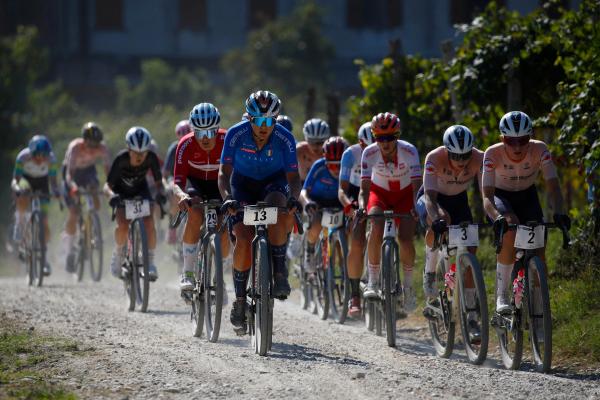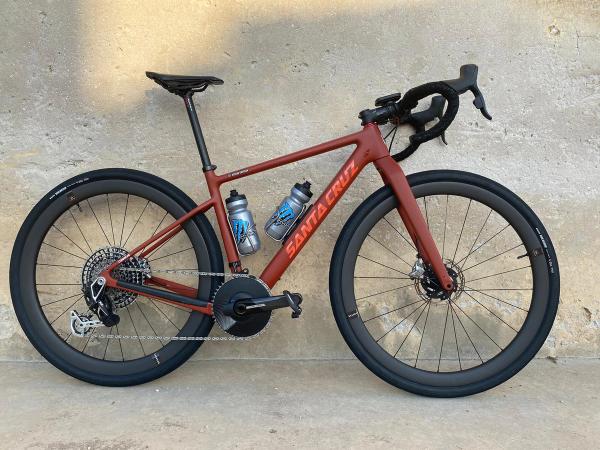Five conclusions from the UCI Gravel World Championships
From the successes to be celebrated to the shortcomings that need to be called out, here are our reflections from the second edition of the UCI Gravel Worlds
Daniel Benson
Editor in Chief
© Sprint Cycling Agency
Kasia Niewiadoma and Matej Mohorič are the new Gravel World Champions
The second edition of the UCI Gravel World Championships took place in Veneto, Italy, over the weekend, with eclectic start lists, thrilling racing, and a sense of adventure as the gravel discipline continues to expand.
The inaugural UCI Gravel Worlds took place in Italy 12 months ago but returned with a more rugged and authentic course, a deeper mix of riders – from road, MTB, and gravel – and a tighter organisation.
That organisation did not, however, include live broadcast of the elite women's race, which cast a shadow over the event, raising deeper questions for the sport and its governors, as well as clear areas for improvement in the future.
GCN Editor-in-Chief Daniel Benson was on the ground at the Worlds throughout the weekend, and shares his reflections on the successes and shortcomings of the event, along with where this leaves the burgeoning discipline of gravel.
TV broadcasts should be the minimum level of gender parity
There’s no other place to start than with the lack of television coverage that was available during the weekend, especially the broadcasting blackout that overshadowed the women’s race.
The men’s race was limited to around an hour of broadcast, while the elite women’s event was reduced to social media text updates and guesswork. In 2023, and at a UCI-endorsed World Championships, it was shamefully disappointing that a governing body – one entrusted with setting the standard for the sport – was so lax in its responsibilities.
There are always going to be mitigating factors and teething issues when it comes to organising and broadcasting events of this magnitude in an ever-expanding discipline, and patience should be provided from fans, media and athletes. But there are limits. The complete lack of women’s coverage was a let-down for the sport.
What’s more, the UCI’s statement on Saturday morning, in which it claimed to have only found out about the lack of broadcasting an hour into the women’s race, was incredibly frustrating, especially given the fact that major broadcasters were already aware of the facts.

© Sprint Cycling Agency
Photographs appeared later from the women's race but it was an exercise in joining the dots
How could the governing body not know well in advance of the situation? And if they did know, why didn’t they proactively mitigate the situation with better social media coverage and a more robust response? Yes, the local organisation of the race changed hands just a few weeks ago, but did the UCI not at that point stipulate that equal broadcasting was a minimum requirement?
UCI President David Lappartient came to power in 2017 with a landslide victory and one of the pillars of his manifesto was to build on women’s cycling and promote equality. During the last seven years there have been major improvements, and when the president and the governing body get it right they deserve credit, but Saturday’s episode was a huge missed opportunity to showcase what many believe was one of the best races of the year.
The UCI has promised that the episode will not be repeated in 2024, with equal coverage for both the men’s and women’s races. Just like the 2017 election manifesto, the UCI must be held to that pledge.
Female athletes to the rescue
Covering a race with limited information is difficult in the extreme but on Saturday afternoon the media were treated to some of the best responses and attitudes athletes could ever display.
At the finish in Veneto, exhausted riders were asked to recount their entire race adventures from start to finish. Media requests of this nature after such demanding conditions and terrain could easily be brushed to one side but the responses we received were unequivocally impressive, engaging and inspiring.

© Sprint Cycling Agency
Newly-crowned world champ Kasia Niewiadoma tells GCN about her ride as the emotion flows out
Rider after rider that GCN spoke to provided almost minute-by-minute stories of their adventures, incredible anecdotes and entertaining quotes that sold and showcased their sport perfectly.
It’s generally unhealthy to enter into a ‘men versus women’ argument but there’s no doubt that female riders are far more accessible and understanding when it comes to promoting their sport. They seem to ‘get it’ in ways others don’t and we’re very, very grateful for that. Of course, in an ideal world it shouldn’t be their responsibility to fill in the blanks, but their insights in this case saved the day.
- Read more: 'I kept getting yelled at by the Italians' - Gravel World Championships through the riders' eyes
These results mattered
It was illuminating and inspiring to see the emotions on display from both Katarzyna Niewiadoma and Matej Mohorič as they crossed the line. Both riders were making their full gravel debuts and it was clear what the rainbow jerseys meant to both victors.
For Niewiadoma it was a first win in four years, and there was no worthier winner after so many near misses and valiant displays. The Polish rider from Canyon-SRAM was immense and dispatched her rivals with clinical precision. “Man she was on a mission today and she put us all to shame,” said Niamh Fisher-Black (New Zealand) who finished eighth. “I think the way she was climbing, it really hurt us.”
Niewiadoma’s raw emotions at the finish and her delight in the gold medal press conference was clear for all to see and demonstrated just how much a rainbow jersey meant to her.
Those sentiments were echoed by Mohorič, who made the UCI Gravel Worlds the final target of his season. It was telling that the Slovenian put this win down as the second biggest victory of his career, after Milan-San Remo. For a rider who has won three Tour de France stages and a stage in the Giro d’Italia, that was huge praise indeed for gravel racing.
WorldTour riders flex their muscles
The only riders in either the men’s or women’s top-10 without WorldTour experience were Keegan Swenson and Simone Boilard. It was a telling indictment of how dominant the road riders were during the weekend of racing.
There were mitigating factors, in that most of the events Swenson dominates in the US are much longer in distance but Nicolas Roche, himself a former WorldTour pro, made the salient point when he described how WorldTour riders can prepare for such one-off events with a string of high quality stage races, including Grand Tours. The Irishman also talked about the fact that the elite road riders are far better supported than some of their off-road competitors, and the results bore fruit.

© Daniel Benson
Keegan Swenson went up against experienced WorldTour pros
At the moment, the gravel specialists aren’t a million miles away from podium challenges but the influx of WorldTour riders is only going to grow in the coming years, leaving the gravel experts potentially with even more ground to make up as they chase rainbows.
Gravel is growing on a global scale
Make no mistake about it, gravel is well and truly enjoying a huge and continued growth spurt. While it’s only fair to criticise the broadcasting situation, one must also pay tribute to how much the Worlds have improved in the last 12 months.
In just a few weeks, the local organisers put on a well-run show, created a much-improved race course than the one on offer last year, and ran a thoroughly organised marquee event that the sport can build on.

© Sprint Cycling Agency
The Veneto course made for great gravel racing
It was telling that the riders themselves were so enthusiastic and positive about the World Championships and that so many of the best riders – from road, MTB and US domestic gravel – took the event so seriously. USA Cycling sent powerful teams, Wout van Aert extended his season, and a crop of men and women from WorldTour teams came days before their races in order to recon their respective courses.
For some time there has been chatter, especially within the US community, that the UCI Worlds should have taken place on home soil but such a move would have only stunted the global growth of the sport and the cross-over with the European WorldTour pros. There was much debate, too, over whether Euro gravel is ‘true gravel’ but interpretation shouldn’t be used to hold the sport back.
Stage racing on the road, whether it’s in Europe or other continents, is still stage racing, and the cultural differences and nuances should only be embraced because the growth of cycling and the more people our sport can encourage onto bikes is only a good thing that helps us all.










.jpg?w=600&auto=format)

